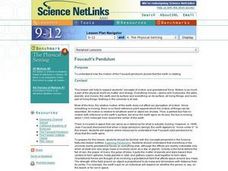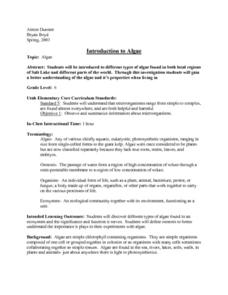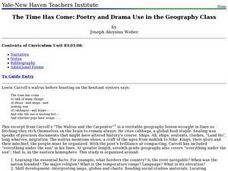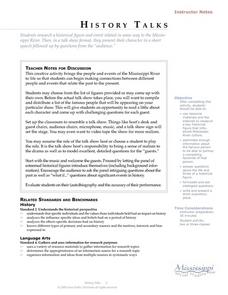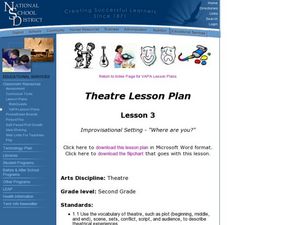Curated OER
Lewis and Clark and Native Americans, Part II
Students research the Native Americans living in the regions explored by Lewis and Clark. They identify the modern-day names of sites claimed by the Lakota Indians, and create a poster of the original Native American names.
Curated OER
Strawberry Girl: Lesson 3 - Trains, Sails, and Trails
Students read two chapters of Strawberry Girl by Lois Lenski and complete activities about Florida's transportation history. In this literacy and economics lesson, students read two chapters of the book, talk about their journal entries,...
Curated OER
Primary Lessons for Grades K-2
Students study wildlife and identify similarities and differences between their home and wild environments. In this wildlife lesson plan, students make connections between wildlife and wildlife habitats. Students then build...
Curated OER
A Second Visit to Deerfield
Students take a virtual tour of the Deerfield Meeting House, circa 1700's, and other turn of the century homes and locations and compare them to modern homes and locations of today.
Curated OER
Foucault's Pendulum
High schoolers investigate how the motion of the Foucault pendulum proves that the Earth is rotating. They research the Internet about pendulums and conduct an experiment online. They view a multimedia presentation about pendulums and...
Curated OER
Westward Expansion
Fifth graders create a brochure outlining what he or she has studied throughout the unit. The brochure contains evidence that Students have understood and mastered the answers to the essential questions.
Curated OER
Introduction to Algae
Students explore different types of algae found in both local regions of Salt Lake and different parts of the world. They discover different types of algae found in an ecosystem and the significance and function it serves.
Curated OER
The Wonderful world of Water
First graders examine the water cycle through readings and experiments. In groups, they conduct interviews with others and use the information to create a chart displaying the various uses of water. After brainstorming lists of ways to...
Curated OER
1920s Images and Ideals PowerPoint Project
Students explore Teaching the American Twenties, noting fashion, life styles, Hollywood, key authors, key people, and key events. They explore the sites and note what they can identify from the time period for this collection. They write...
Curated OER
America Moves Out!
First graders analyze the events of early American exploration. This is a unit resource for teachers in which there are six lessons about the American Western exploration and expansion. Within each lesson there are objectives, materials,...
Curated OER
Story Stretching: Tall Tales in North America
Students are introduced to tall tales. In this introductory tall tales unit, students explore the tall tales of Casey Jones and Johnny Appleseed. This unit includes many interdisciplinary lessons including graphing skills and geography.
Curated OER
Timeline of Extreme Weather Events
Students research and chart extreme weather events on a timeline. In this extreme weather lesson, students interview older people who have experienced extreme weather events. Students complete a worksheet based on the information of the...
Curated OER
Local Hydrologic Cycle
Students draw the water cycle as it occurs in their community. In this water cycle lesson, students observe demonstrations of sublimation and infiltration. They also use photographs or their own drawings of their...
Curated OER
Extreme Weather
Students examine different types of extreme weather and how to prepare for them. In this weather lesson students explore different types of extreme weather and create disaster preparation posters for different types of extreme weather.
Curated OER
Pond Life
Environmental explorers create an experiment related to ponds and then present their finding to the class. This resource is extremely open-ended. It needs more concrete objectives and procedures for meeting them.
Curated OER
Landforms in a Tub
Fifth graders use common household items to build landforms and simulate weathering and erosion.
Curated OER
The Time Has Come: Poetry and Drama Use in the Geography Class
Students use drama and poetry in their Geography class. In groups, they role play an interviewer or the interviewee in various plays that were presented to them. In their role, they must locate and label where the countries mentioned...
Curated OER
Managing the Everglades Ecosystem
Students explore the Everglades ecosystem using the Internet. To develop a picture about conservation of resources in the context of the Everglades. Explore relationships between species and habitats. Develop an idea of how human beings...
Curated OER
Mystery Creek
Fourth graders are introduced to the Riparian Ecosystem. They define the following terms: riparian and riparian ecosystem. Students take a trip to the creek, where they make observations about the environment around them. They are...
Curated OER
Water, Water Everywhere (Pond Animals)
Second graders examine the characteristics of animals who live in a pond environment. In groups, they describe the various stages in the life of a frog and identify the characteristics of other pond animals. Using this information,...
Curated OER
History Talks
Students engage in a lesson that deals with a historical figure from the area of Mississippi. Then questions are asked of them using a game show format that is followed with additional ones used for brainstorming for more ideas of inquiry.
Curated OER
Meso-America
Students will identify and locate Central and South America and their countries and features, as well as Meso-American civilizations. Students will compare civilizations and discuss voyages of relevant explorers.
Curated OER
From cotton to Baseball: How Greenville Grew
Eighth graders explore the impact of textile production and baseball of the mills and communityof Greenville SC
Curated OER
Improvisational Setting - "Where are You?"
Second graders explore setting through improvisations. In this theatre lesson plan, 2nd graders perform a variety of improvisations in different settings and chart how they established the setting in the different environments.






